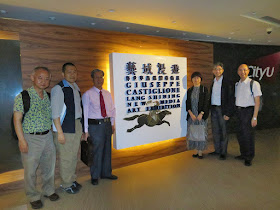The Post-World
Summit for Chinese Quality (WSCQ) seminar on Extenics (可拓學) was organized by Hong Kong Society for Quality (HKSQ) and
Department of Systems Engineering and Engineering Management (SEEM), City
University of Hong Kong on 9 July 2016. Before
the seminar, I introduced the background of WSCQ and its theme was Quality and
Innovation. Therefore, we invited Prof.
Cai Wen (蔡文) and Prof.
Yang Chunyan (楊春燕) to be our guest speakers to continue the yesterday keynote for more
details introduction.
Then we
took a group photo for memory. Most
participants come from industry.
Prof. Yang
Chunyan (楊春燕)
(Director, Institute of Extenics and Innovation Methods, Guangdong University
of Technology) was the first speaker and her topic entitled “Extensive Innovation
Method” (可拓創新方法). Firstly, she introduced the Four Steps of
Extensive Innovation (可拓創新四步法) included Model (建模), Extension (拓展), Transformation (變換) and Selection (選擇).
Then Prof.
Yang used a pen as an example to introduce Basic-element (基元) theory. Pen as object used to build model we called
it Matter-element (物元) which included the pen’s characteristics and values. And then Prof. Yang used the function of pen
to explain Affair-element (事元). Pen used to write which was an
action. Its characteristics include who
used it, what to be done after use it and what method to be used, when and
where to use it, etc. Finally, Prof.
Yang employed the pen’s structure (or components) to explain the Relationships-element
(關係元).
After
those consideration, a Model of Pen’s Basic-element (基元) was established. The purpose to build such model was to
facilitate standardization, refinement, quantitative and computerization.
Prof.
Yang introduced Extension Analysis (拓展分析) that included Divergence (發散樹), Correlative (相關網), Implication (蘊含系) and Opening-up (分合鏈).
The four
conjugation pairs were also discussed and they were “Nonmaterial part (虛部) vs Material part (實部)”, “Soft part (軟部) vs Hard part (硬部)”, “Latent part (潛部) and Apparent part (顯部)” and “Negative part (負部) and Positive part (正部)”, as well as “Intermediate part
(中介部)” in each
pairs .
Lastly,
Prof. Yang briefed the Selection (選擇) in seven steps. Industry needed to participate in the first
three steps that were to select the measurable objectives, confirmation of
weighting and first evaluation.
Prof. Cai Wen (蔡文) (Founder of Extenics and The Director of International Academy of Extenics (HK)) was the second speaker and his topic named “Creative Thinking Revolution - Extensive Innovation Method” (創意的革命—可拓創新方法). Firstly, Prof. Cai discussed the Conjugation Analysis in more details.
Some
examples employed Conjugation pairs were discussed as follows.
-
“Nonmaterial part (虛部) vs Material part (實部)” - The Empty Fort (諸葛亮的空城計)
-
“Soft part (軟部) vs Hard part (硬部)” – Two Chinese sayings: “one boy is a boy, two boys half a boy, and
three boys no boy” (三個和尚沒水喝) and “Three heads are better than one” (三個臭皮匠,勝過一個諸葛亮。)
-
“Negative part (負部) and Positive part (正部)” – UK prisoner boat incident and then policy changed from “Off-shore
number” to “Landed number” so as to solve the problem.
-
“Latent part (潛部) and Apparent part (顯部)” – As iceberg that we only observed the top one above water.
After
that Prof. Cai use this four conjugation pairs to develop new product.
He said
that new product creation had three innovation methods. The first one was come from customer need
which had not been fulfilled. (從需要出發,無中生有)
Second
innovation method was from existing product in which employed extenics theory to
transform and improve to be new product. (從已有的產品出發)
The third
one was come from the disadvantages of existing product. (從現有產品的缺點出發)
Another
usage of Four Steps of Extensive Innovation was to solve the contradiction problems.
After
the presentation, I on behalf of HKSQ presented souvenir to Prof. Cai Wen and Prof.
Yang Chunyan.
Then I
took a photo with all my teachers.
(Left:
I, Prof. Yang Chunyan, Dr. K.S. Chin, Prof. Cai Wen and Prof. KF Pun)
Group
photo for professionals
(Left:
Mr. Peter Fung, Dr. Victor Lo (ISIHK), Dr. Aaron Tong, Dr. CO Chan (ISSC),
Prof. Yang Chunyan, Prof. Cai Wen, Prof. KF Pun, Dr. YC Chow, Dr. KS Chin and
I)
Then we had
lunch together.
Finally,
we led Prof. Cai Wen and Prof. Yang Chunyan to visit the art exhibition in
CityU.
It
combined art and information technology together.
Reference:
廣東工業大學可拓學與創新方法研究所 - http://web.gdut.edu.cn/~extenics/hyanjiusuo.htm
20160229:
HKCIE Seminar on Extenics (可拓學) - http://qualityalchemist.blogspot.hk/2016/02/hkcie-seminar-on-extenics.html
Research Institute of Extenics and Innovation
Methods, GDUT (廣東工業大學可拓學與創新方法研究所) - http://web.gdut.edu.cn/~extenics/hyanjiusuo.htm
Previous Extenics activities:
20160708: The 1st
World Summit for Chinese Quality - http://qualityalchemist.blogspot.hk/2016/07/the-1st-world-summit-for-chinese-quality.html
20160628: Innovation
Product Development Seminar - Extenics (可拓學)
application in Shenzhen - http://qualityalchemist.blogspot.hk/2016/06/innovation-product-development-seminar.html
20160605: The 2nd
meeting of the Innovation Alliance of the Extenics (可拓學) - http://qualityalchemist.blogspot.hk/2016/06/the-2nd-meeting-of-innovation-alliance.html
20160522: The meeting with Prof. Cai Wen for
promoting the Extenics (可拓學)
to Hong Kong - http://qualityalchemist.blogspot.hk/2016/05/the-meeting-with-prof-cai-wen-for.html
20160507: The meeting for establishing the Innovation
Alliance of the Extenics and its application and promotion - http://qualityalchemist.blogspot.hk/2016/05/the-meeting-for-establishing-innovation.html
20160506: Visit to the Institute of Extenics
and Innovation Methods and HKQAA Guangzhou office - http://qualityalchemist.blogspot.hk/2016/05/visit-to-institute-of-extenics-and.html
20160416: Patent Analysis and Corporate
Development Series 2016 - Extenics (可拓學) - http://qualityalchemist.blogspot.hk/2016/04/patent-analysis-and-corporate.html
20160229: HKCIE Seminar on Extenics (可拓學) - http://qualityalchemist.blogspot.hk/2016/02/hkcie-seminar-on-extenics.html





















沒有留言:
發佈留言